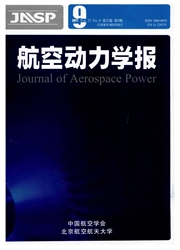

 中文摘要:
中文摘要:
用数值模拟的方法研究了二维壁面的表面粗糙度下Stokes层的非线性亚临界不稳定性问题.发现当粗糙度高度极小时,响应系数曲线与线性情况就会产生较大偏离.随着粗糙度高度的增加,扰动1阶谱会出现亚谐波的成分,粗糙度高度的进一步增加使扰动1阶谱进入混乱阶段,显示出亚临界失稳的过程.根据粗糙度高度与扰动1阶谱演化的特征关系,定义了临界粗糙度高度,并给出临界粗糙度高度与雷诺数的关系曲线.结果表明:临界粗糙度高度随着雷诺数增大而减小.雷诺数为300左右时,微米量级的粗糙度高度就可能引起Stokes层的亚临界失稳,发生转捩,由此也可以给出实验中观测到的转捩通常都发生在雷诺数为300附近的原因.
 英文摘要:
英文摘要:
The subcritical instability problem of a finite Stokes layer over two-dimensional wall surface roughness was investigated by numerical simulations.Results indicated that infinitesimal height of roughness led to a quite large deviation of the response curves from the linear cases.With the increasing height of wall roughness,the evolution of the disturbance at one order spectrum displayed the sub-harmonic component,and then the evolution entered into the irregular state,indicating the subcritical instability.According to the correlation between the height of roughness and the disturbance at one order spectrum evolution,the critical height of roughness was defined,and the relation curve was given as a result.Results shows that the critical height of roughness becomes smaller as the Reynolds number increases.At the Reynolds number around 300,the height of roughness of just the level of micrometer would be able to trigger the subcritical instability and transition in Stokes layer.That is why transition often occurs in experimental observations at Reynolds number around 300.
 同期刊论文项目
同期刊论文项目
 同项目期刊论文
同项目期刊论文
 期刊信息
期刊信息
